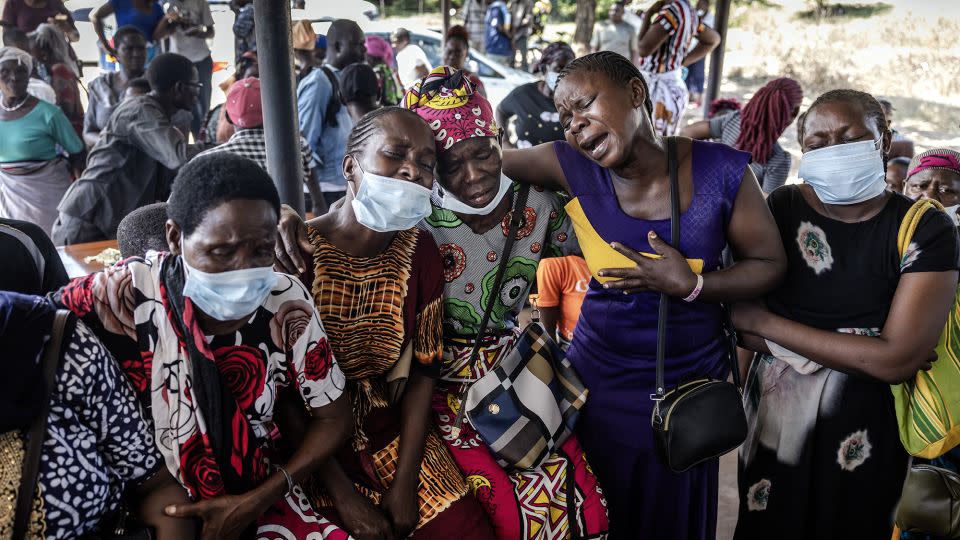Kenyans struggle to comprehend starvation cult massacre as first bodies are finally released for burial
The family members clutched each other and wailed as attendants pulled small bundles out of the funeral van. Remains so degraded that a handwritten card identified each victim of the cult.
“I did not believe to see my people the way they are. The condition is very bad,” Francis Wanje told CNN.
“It has been a very tough journey from last year to now. A very tough one. Fortunately, I am happy that I’ve gotten [my] loved ones,” he said, after receiving their bodies.
On Tuesday, Wanje became the first family member to retrieve the bodies of his relatives for burial after they became victims of a tragedy, dubbed the Shakahola massacre, that many Kenyans find hard to comprehend. In the days and weeks to come, authorities hope to release more bodies back to families.
Witnesses and prosecutors say that starting in 2019 and over a period of many months, charismatic pastor Paul Nthenge MacKenzie, a former taxi driver living in Malindi, lured hundreds of followers to the remote Shakahola forest to prepare for the end of the world.


Government officials and survivors contend that he convinced followers to starve themselves to death to reach salvation, starting with the children. Autopsies show that most died of starvation, while others were bludgeoned to death.
In June last year, CNN reported on how authorities were slow to react to rumors coming from the cult commune.
Now a scathing official report, released this month by the Kenya National Commission on Human Rights (KNCHR), has outlined a pattern of failure, delays and negligence in the government response that the Commission says could have contributed significantly to the awful scale of the tragedy.
“The Commission faults the then security team in Malindi for gross abdication of duty and negligence,” the 33-page report reads. It describes how authorities failed to act on credible intelligence of the cult activities from several sources, alleging that they could have saved more lives.
The Commission found that police ignored numerous reports filed at the local police station, authorities ignored warnings about radicalization at meetings, and how, in one case, a former follower was admonished and intimidated after posting specific warnings about the pastor and Shakahola on social media. Instead, they accepted a complaint from the pastor himself about the posts.
In the two years before he retreated with his followers to the forest, MacKenzie had also been arrested on suspicion of radicalization several times.
“The negligence and failure of the security and administration structures left MacKenzie’s followers at the full control and mercy of MacKenzie and his militia,” the KNCHR report reads.
Kenya’s interior cabinet secretary, Kithure Kindiki, has repeatedly apologized for the failures of the government response. Security officers were transferred from the area. Yet promises of more serious penalties have not materialized, despite a government commission of enquiry.
Closure for very few
Wanje found out the truth about the cult early last year, when he received a tip that his daughter and her family had moved into the forest with the pastor.
Wanje organized a private rescue mission. When they arrived in the remote forest compound, they found his oldest grandchild – deeply malnourished and near death. Two of his siblings were already dead.
When CNN spoke to Wanje last year, he said the boys were suffocated by their parents.
“It’s so painful, I could not even explain it because it’s something that I didn’t even think of in my life,” he said.
“And I wonder how my child, my daughter, could change to be such an animal to kill her own children just because she wanted to go see Jesus.”

Wanje said that his daughter and son-in-law escaped the compound when the rescue team entered, but their bodies were later recovered by the state from the surrounding forest. All in all, Wanje believes eight of their extended family are among the victims. The surviving grandchild is now healthy and in school.
Forensic experts and volunteers have spent months finding and digging up remains of the cult members. So far, authorities say they have found 429 victims.
Of those, only 34 positive DNA matches to surviving family members have been made, said Kenya’s chief pathologist, Johansen Oduor.
He said this was because collecting DNA from the remains has been challenging, while family members haven’t all been willing to go through with the process, as transporting and burying the bodies can be expensive and many don’t want the stigma of collecting former cult members. On Wednesday, the government said those who could not pay would be supported.
Prosecutors finally charged Mackenzie and scores of his senior leadership in January on a series of charges including the murder of 191 children. The pastor and cult leadership have repeatedly denied any wrongdoing.
But the scale of the tragedy is still unclear. Soon the fifth and final phase of exhumations will begin.
It is expected that the death toll could then rise by several hundred, said Irungu Houghton, executive director of Amnesty international in Kenya. “If we put those figures together this single massacre, this mass crime, probably has combined more deaths than several terror attacks we’ve seen.”
For more CNN news and newsletters create an account at CNN.com


